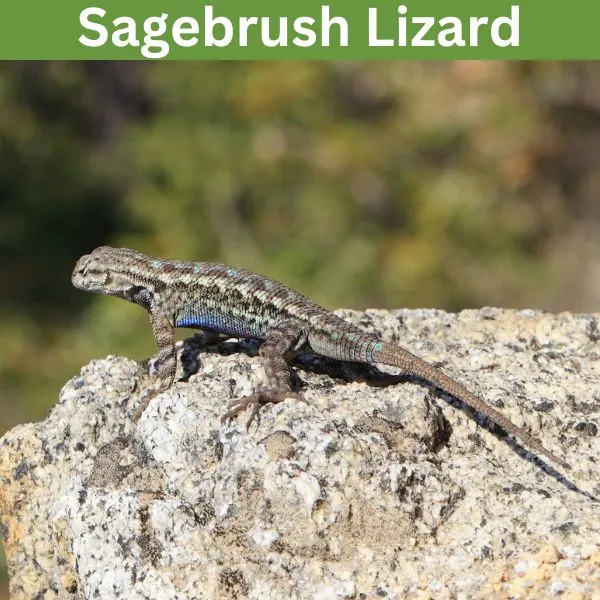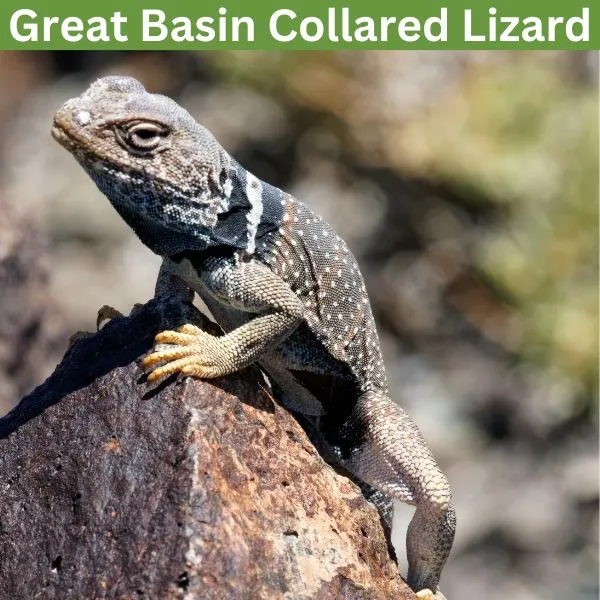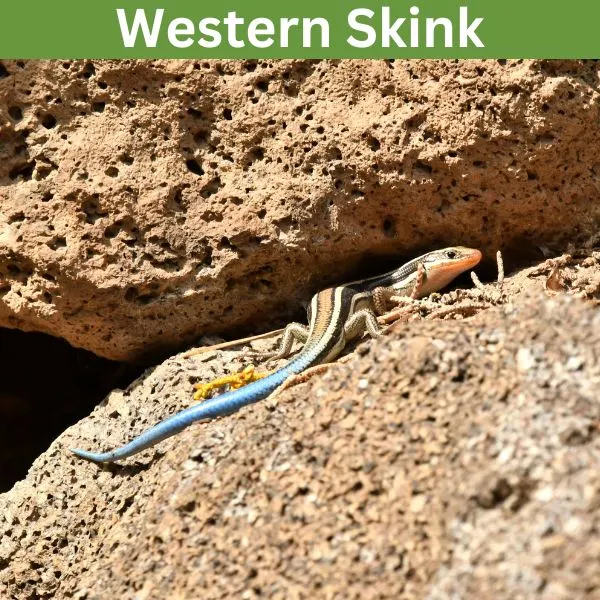In Idaho there are 11 lizard species that live in the state. Reptiles, and amphibians are one of the more mysterious animals in Idaho, but when you have the right knowledge it can become easy to find them in the wild.
Here, this article will take a look at the 11 lizards that live in Idaho, and the important things that you should know about them. Some of the things like a lizard’s features, size, colors, and where it lives can be very beneficial in finding, and identifying lizards near you.
Table of Contents
Lizards in Idaho
Teiidae
1. Western Whiptail

- Experience Level: Intermediate
- Family: Teiidae
- Scientific Name: Aspidoscelis tigris
- Other Names: n/a
- Adult Size: 9.8 to 13.7 in. (25 to 35 cm.)
- Lifespan: 7 years
- Average Price Range: n/a
Western whiptails are a lizard native to the southeastern United States. These lizards are native to Idaho, and are found in the southern portion of the state. Western whiptails live in sagebrush, and semi-arid desert habitats.
The bodies of these lizards are long, and slender. They have a tan, olive, or brown coloring, with yellowish stripes running down their body. They can also have dark blotches on them, with coloring helping them blend into their sandy habitat.
Western whiptails are very common, with a stable population across their range. They feed on spiders, insects, grasshoppers, and other types of small invertebrates they come across.
When attacked these lizards are able to drop their tail, but this takes very long for them to grow back, and puts them under lots of stress. Breeding for this species occurs with both males, and females, and they lay their eggs in the summer and fall.
Phrynosomatidae
2. Common Sagebrush

- Experience Level: Intermediate
- Family: Phrynosomatidae
- Scientific Name: Sceloporus graciosus
- Other Names: Sagebrush swift
- Adult Size: 2 to 5.9 in. (5 to 14.98 cm.)
- Lifespan: 5 years
- Average Price Range: n/a
Common sagebrush lizards are native to Idaho, and found in the majority southern portion of the state. These lizards live in deserts, woodlands, grasslands, and shrubland habitats. They are more common in the semi-arid, western regions of the United States.
The bodies of this lizard are robust, and they have a tannish, olive, or gray coloring. Males may have a bright blue coloring on them, which helps them attract mates in the breeding season. These lizards are small, with white bellies, and roughly keeled scales.
Common sagebrush lizards startle easily, and may hide in burrows, under rocks, or climb up trees. Their appearance also helps them camouflage, and avoid predators like birds, carnivorous mammals or larger lizards. When mating females lay around 5 to 6 eggs, and play them in a burrow until they hatch.
3. Western Fence Lizard

- Experience Level: Intermediate
- Family: Phrynosomatidae
- Scientific Name: Sceloporus occidentalis
- Other Names: Blue-belly lizard
- Adult Size: 4 to 7.5 in. (10 to 19 cm.)
- Lifespan: 5 to 7 years
- Average Price Range: $20
Western fence lizards are native to the western United States, and are a common lizard in Idaho. Urban areas, woodlands, and grassland habitats are where you may find this species. They enjoy climbing, and are often seen on fences, or other large structures.
The scales of these lizards are very roughly keeled, and they have a medium sized body. Tan, gray, or black are the colors these lizards appear in. Males may have blue on their stomachs and neck.
Insects and other small invertebrates are what this lizard eats in the day. They often get preyed on by animals like foxes, larger lizards and snakes. Western fence lizards are active in the day, and often hide so may not be seen.
4. Greater Short-horned Lizard

- Experience Level: Intermediate
- Family: Phrynosomatidae
- Scientific Name: Phrynosoma hernandesi
- Other Names: Mountain short-horned lizard
- Adult Size: 6 in. (15 cm.)
- Lifespan: n/a
- Average Price Range: $40
Greater short horned lizards live in the western regions of North America. This lizard is found in habitats like mountains, woodlands, and sagebrush deserts. They prefer dry areas, with sparse vegetation.
This lizard is very similar to the pygmy short-horned lizard, but they can be told apart by their larger size, and dna. Greater short-horned lizards have a tan, reddish brown, or gray coloring, with lots of spikes covering them for protection.
Greater short-horned lizards feed on harvest ants, and hang around their homes for an easy meal. They use their spikes, camouflage, but also squirt blood from their eyes to fight off predators. Cats, dogs, larger lizards, birds, and snakes are common predators for this lizard, but even red ants can be an issue for them.
5. Pygmy Short-horned Lizard

- Experience Level: Intermediate
- Family: Phrynosomatidae
- Scientific Name: Phrynosoma douglasii
- Other Names: n/a
- Adult Size: 1 to 3 in. (2.5 to 6.5 cm.)
- Lifespan: 10 years
- Average Price Range: n/a
Pygmy short-horned lizards are a small horned lizard found in Idaho, and other regions in the western United States. In Idaho these lizards can be seen year round, and their populations mainly occur in the western part of the state.
Small in size, these lizards are covered in spikes, with a tan, gray, yellow, or reddish color. They have dark blotches on them, with some white markings. Their spikes help them look like the sparse vegetation they often hide in.
Ants are what the majority of what this lizard eats, but they may sometimes be preyed on by red ants. These lizards hang around ant hills, and are active in the day hunting. They use burrows to sleep, or other debris. They sometimes hibernate in the winter underground when it gets too cold.
6. Desert Horned Lizard

- Experience Level: Intermediate
- Family: Phrynosomatidae
- Scientific Name: Phrynosoma platyrhinos
- Other Names: n/a
- Adult Size: 3.75 in. (9.5 cm)
- Lifespan: 5 to 8 years
- Average Price Range:$40
The desert horned lizard is one of the several horned lizard species that lives in Idaho, and this species is mainly found in the southern portion of the state. Desert horned lizards get their name from the several horns that come out of their body. They live in habitats with lots of sand, and sparse vegetation.
Southern Idaho until northern Mexico is where these lizards live. The spikes on them help defend from predators, as they puff up their bodies to make themselves less palatable. Ants, and other small insects are what this species mainly eats.
Desert horned lizards are common in their ragne, with a stable population. These lizards, unlike their relatives, do not often shoot blood from their eyes, but their smaller size and camouflage helps keep them safe.
7. Common Side-blotched Lizard

- Experience Level: Beginner
- Family: Phrynosomatidae
- Scientific Name: Uta stansburiana
- Other Names: n/a
- Adult Size: 2.5 to 5 inches (6.35 to 12.7 cm.)
- Lifespan: 1 year
- Average Price Range: $12
In Idaho the common side-blotched lizard is found in the southwestern corner of the state. These lizards are native to the western United States. They are found in dry habitats like grasslands, and deserts.
Common side-blotched lizards get their name from the dark spot that appears on their side. They have a tan, orange, or yellow coloring, with bodies filled with roughly keeled scales. Males of this species can have a blue, yellow, or orange through.
On average these lizards aly around 5 to 9 eggs in a clutch. Males are either aggressive, secretive, or mildly aggressive when mating, and the color of their throat determines how they breed.
Side-blotched lizards feed on small insects, grasshoppers, and other insects during the day. Their camouflage and hiding ability is how they mainly defend themselves.
8. Great Basin Collared Lizard

- Experience Level: Beginner
- Family: Phrynosomatidae
- Scientific Name: Uta stansburiana
- Other Names: n/a
- Adult Size: 2.5 to 5 inches (6.35 to 12.7 cm.)
- Lifespan: 1 year
- Average Price Range: $12
Great Basin collared lizards are native to Idaho. These lizards are found in the western United States in the Great Basins, Sonoran, and Mojave deserts. Great Basin collared lizards have a stable population, but are not seen often due to their restricted habitat.
Around their neck this species has a black collared marking that appears on them. Males of this species are more colorful than females, and may have a brown, orange, to pinkish coloring. Females are darker, with brown or black coloring. Stripes, and blotches cover this lizard from head to toe.
Great Basin collared lizards use their strong jaws to feed on things like snakes, lizards, and insects. They sometimes eat plants, and fruit, and are opportunistic feeders.
9. Long-nosed Leopard Lizard

- Experience Level: Intermediate
- Family: Crotaphytidae
- Scientific Name: Gambelia wislizenii
- Other Names: n/a
- Adult Size: 3.25 to 5.75 in. (8.225 to 14.6 cm.)
- Lifespan: 5 to 8 years
- Average Price Range: $20
Native to the state, in Idaho the long-nosed leopard lizard is found in the southern portion of the state. These lizards are found in grasslands, and semi-arid environments. Long-nosed leopard lizards are mainly found in the western United States.
These lizards have a white, gray, or cream coloring. They have dark blotches covering their body, with very long tails. The spots on these lizards have a rusty coloring, and their appearance helps them blend into the sandy environments they live in.
Long-nosed leopard lizards are active in the day, and are seen most in the morning.They enjoy basking on rocks and will freeze if spotted. Long-nosed leopard lizards feed on small lizards, and insects. They may be preyed on by animals like coyotes, birds, and snakes.
Anguidae
10. Northern Alligator Lizard

- Experience Level: Intermediate
- Family: Anguidae
- Scientific Name: Elgaria coerulea
- Other Names: n/a
- Adult Size: 10.8 in. (27.5 cm.)
- Lifespan: 7 years
- Average Price Range: $50
Northern alligator lizards are found in the western United States. They live in woodlands, and chaparral habitats. In Idaho northern alligator lizards live in the northern portion of the state. The summer and fall is when these lizards breed, and they lay up to 15 live young.
These lizards are medium-sized, with brown, green, or olive color. They have dark markings on them, with square scales. Northern alligator lizards have dark eyes with gray bellies.
These lizards feed on small insects like slugs, spiders, and even small mice since they are opportunistic feeders. Northern alligator lizards are active in the day, and when not active hide under rocks, or other debris like logs. While not as common as other lizards, their populations are abundant across their range.
Scincidae
11. Western Skink

- Experience Level: Beginner
- Family: Scincidae
- Scientific Name: Plestiodon skiltonianus
- Other Names: n/a
- Adult Size: 4 to 8.25 in. (10.16 to 20.95 cm.)
- Lifespan: 10 years
- Average Price Range: n/a
The western skink is the only skink species that lives in Idaho. These lizards are native to the western United States, and in Idaho, can be sighted across the majority of the state. Western skinks live in woodlands, grasslands, and other moist habitats, even urban areas.
Western skinks are active in the day, and spend their time feeding on small invertebrates. They mate in the warmer season, with females laying around 2 to 6 eggs in the summer. Western skinks can live for up to 1 year, and reach sexual maturity in around 3 years.
The bodies of these lizards are very slender, and their scales are smooth. When born skinks have bright blue tails, which they can drop. Tan, olive, and black coloring appear on them, and they have stripes running down their body.
Western skinks have a stable population ,and are very common across their range. They are not seen often in winter due to hibernation, and this species may hide in communinal dens with one another.
What lizards are most common in Idaho?
Sagebrush lizards, skinks, and fence lizards are the most common lizards that live in Idaho. Several lizards are found in near homes, and residential areas, and can adapt to these environments.
Are there dangerous lizards in Idaho?
In Idaho the lizards that live in the state are harmless to humans. Lizards are very docile, and if approached will flee. They cannot harm humans with their bites, but may carry germs that can be dangerous.
Wrapping up
In Idaho there are several species in the state that are native, but a few are invasive. While lizards can make great pets, it is not suggested you take lizards from the wild to keep. Lizards from the wild can carry diseases, but also are a part of an important ecosystem.
Reptiles require the right care, and environment to thrive. In many places in the wild lizard populations are threatened due to pollution, habitat destruction, and other deaths caused by humans. Learning, and discovering the wonders about these lizards is interesting, and helps people learn how to better preserve these wonderful animals.
Other exotic species in Idaho
